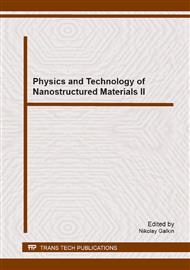[1]
A.F. Ioffe, Physics of semiconductors, Nauka, Moscow, (1957).
Google Scholar
[2]
L.T. Canham, Visible photoluminescence of porous Si, Appl. Phys. Lett., 57 (1990) 1046-1049.
Google Scholar
[3]
S. Sawada, N. Namada, N. Ookubo, Mechanism of visible photoluminescence of porous silicon, Phys. Rev. B, 49 (1994) 5236-5245.
DOI: 10.1103/physrevb.49.5236
Google Scholar
[4]
D. Dimova-Malinovska, M. Sendova-Vasileva, T. Marinova, V. Krastev, M. Kamenova and N. Tzenov, Correlation between the photoluminescence and chemical bonding in porous silicon, Thin Solid Films, 276 (1996) 290-292.
DOI: 10.1016/0040-6090(94)05652-t
Google Scholar
[5]
L. T. Canham, A. Lioni, P.D. Calcott, A.J. Simons, C. Reeves, M.R. Houlton, J.P. Newey, K.J. Nash and T.I. Cox, On the origin of blue luminescence arising from atmospheric impregnation of oxidized porous silicon, Thin Solid Films, 276 (1996).
DOI: 10.1016/0040-6090(95)08072-4
Google Scholar
[6]
F. Kozlovski, A. Wiedenhofer, W. Wagenseil, P. Steiner and W. Lang, Stability of photoluminescence and electroluminescence of porous silicon, Thin Solid Films, 276 (1996) 284-286.
DOI: 10.1016/0040-6090(95)08097-x
Google Scholar
[7]
T. Dittrich, H. Flietner, V. Yu. Timoshenko and P.K. Kashkarov, Influence of the oxidation process on the luminescence of HF-treated porous silicon, Thin Solid Films, 255 (1997) 149-151.
DOI: 10.1016/0040-6090(94)05642-q
Google Scholar
[8]
N.A. Sobolev, Silicon by erbium doped – new semiconductor for optoelectronics, Rus. Chem. Journ., XLV (2001) 95-101.
Google Scholar
[9]
S.W. Choi, W.B. Choi, Y.H. Lee and B.K. Ju, Effect of oxygen plasma treatment on anodic bonding, Journ. of Kor. Phys. Soc., 38 (2001) 207-209.
Google Scholar
[10]
F.B. Baimbetov, B.M. Ibraev, A.M. Zhukeshov, Silicon surface under the action of compression plasma flow, Semiconductors, 36 (2002) 197-198.
DOI: 10.1134/1.1453436
Google Scholar
[11]
N.G. Galkin, E.A. Chusovitin, K.N. Galkin, V.M. Astashinski, A.M. Kuzmitski, A.A. Mishchuk, Morphology, optical properties and band structure parameters of monocrystalline silicon modified by compression plasma flow, Proceedings of Nanomeeting-2007, Ed.: V.E. Borisenko, S.V. Gaponenko, V.S. Gurin, World Scientific Publishing Company, Singapore, (2007).
DOI: 10.1142/9789812770950_0112
Google Scholar
[12]
V.M. Astashinski, S.I. Ananin, A.S. Emelyanenko, E.A. Kosytukevich, A.M. Kuzmitski, S.P. Zhvavy, V.V. Uglov, Bulk periodic strucrures formation on monocrystalline silicon surface under the action of compression plasma flow, Applied Surface Science, 253 (2006).
DOI: 10.1016/j.apsusc.2006.03.023
Google Scholar
[13]
I.P. Dojcinovic, M.M. Kuraica and J. Puric, Diagnostis of silicon submicron cylindrical structures obtained by plasma flow action, Vacuum, 80 (2006) 1381-1385.
DOI: 10.1016/j.vacuum.2006.01.020
Google Scholar
[14]
Y.A. Petukhou, V.V. Uglov, N.T. Kvasov, A.V. Punko, I.L. Dorochevich, V.M. Astashinski, A.M. Kuzmitski, Formation of silicon-based nanostructures by compression plasma flow, Nanomaterials: application and properties (NAP-2011), 1 (2011) 440-447.
DOI: 10.1016/j.apsusc.2012.04.035
Google Scholar


